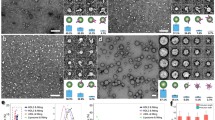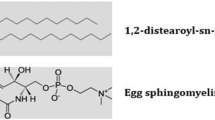Abstract
Serum paraoxonase 1 (PON1) is a high-density lipoprotein (HDL)-bound mammalian enzyme exhibiting antiatherosclerotic activity. Despite years of research, an accurate model for the binding interaction between PON1 and HDL has not been established. However, it is reported that anchoring of PON1 to HDL is mainly governed by an N-terminal alpha helix H1 and another short helix H2. Here, we studied the molecular association of full-length human PON1 (huPON1) with a HDL-mimetic dipalmitoylphosphatidylcholine (DPPC) bilayer using homology modeling and molecular dynamics simulations. Our results indicate that H1 is the highly dynamic part of huPON1, showing clockwise rotation of up to 30° within the DPPC bilayer. However, without phospholipid molecules, H1 experiences helical distortions, illustrating an incompatible HDL-anchoring conformation. Snorkeling interactions of K3, R18, and R27 together with aromatic locks formed by Y187, Y190, W194, and W202 are highly essential for anchoring of huPON1 to HDL’s surface. Molecular mechanics/Poisson–Boltzmann solvent-accessible surface area (MM/PBSA) binding free energy calculation revealed that H1 displays greater binding affinity towards lipid molecules compared with H2 and H3, suggesting that H1 is the most probable HDL-binding domain of PON1. Binding free energy decomposition showed that K3, R18, and R27 interact with polar headgroups of DPPC membrane through electrostatic interaction. Moreover, Y187, Y190, W194, and W202 interact with DPPC lipids mainly through van der Waals interaction. Taken together, these results show that the transmembrane helix H1 along with the interfacial positively charged and aromatic resides were crucial for PON1’s association with HDL particle. The current study will be useful towards understanding the antiatherosclerotic and bioscavenging properties of this promiscuous enzyme.












Similar content being viewed by others
References
Allen WJ, Lemkul JA, Bevan DR (2009) GridMAT-MD: a grid-based membrane analysis tool for use with molecular dynamics. J Comput Chem 30:1952–1958
Altschul SF, Gish W, Miller W et al (1990) Basic local alignment search tool. J Mol Biol 215:403–410
Amadei A, Linssen AB, Berendsen HJ (1993) Essential dynamics of proteins. Proteins 17:412–425
Aviram M, Rosenblat M, Bisgaier CL et al (1998) Paraoxonase inhibits high density lipoprotein (HDL) oxidation and preserves its functions: a possible peroxidative role for paraoxonase. J Clin Invest 101:1581–1590
Baker NA, Sept D, Joseph S (2001) Electrostatics of nanosystems: application to microtubules and the ribosome. Proc Natl Acad Sci USA 98:10037–10041
Ben-David M, Elias M, Filippi JJ et al (2012) Catalytic versatility and backups in enzyme active sites: the case of serum paraoxonase 1. J Mol Biol 418:181–196
Berger O, Edholm O, Jahnig F (1997) Molecular dynamics simulations of a fluid bilayer of dipalmitoylphosphatidylcholine at full hydration, constant pressure, and constant temperature. Biophys J 72:2002–2013
Colovos C, Yeates TO (1993) Verification of protein structures: patterns of nonbonded atomic interactions. Protein Sci 2:1511–1519
Cristobal S, Zemla A, Fischer D et al (2001) A study of quality measures for protein threading models. BMC Bioinf 2:5
Davies HG, Richter RJ, Keifer M et al (1996) The effect of the human serum paraoxonase polymorphism is reversed with diazoxon, soman and sarin. Nat Genet 14:334–346
de Planque MR, Bonev BB, Demmers JA et al (2003) Interfacial anchor properties of tryptophan residues in transmembrane peptides can dominate over hydrophobic matching effects in peptide–lipid interactions. Biochemistry 42:5341–5348
Deol SS, Bond PJ, Domene C et al (2004) Lipid–protein interactions of integral membrane proteins: a comparative simulation study. Biophys J 87:3737–3749
Draganov DI, La Du BN (2004) Pharmacogenetics of paraoxonases: a brief review. Naunyn Schmiedebergs Arch Pharmacol 369:78–88
El Harchaoui K, Arsenault BJ, Franssen R et al (2009) High-density lipoprotein particle size and concentration and coronary risk. Ann Intern Med 150:84–93
Fairchild SZ, Peterson MW, Hamza A et al (2011) Computational characterization of how the VX nerve agent binds human serum paraoxonase 1. J Mol Mod 17:97–109
Gaidukov L, Tawfik DS (2005) High affinity, stability, and lactonase activity of serum paraoxonase PON1 anchored on HDL with ApoA-I. Biochemistry 44:11843–11854
Gaidukov L, Rosenblat M, Aviram M et al (2006) The 192R/Q polymorphs of serum paraoxonase PON1 differ in HDL binding, lipolactonase stimulation, and cholesterol efflux. J Lipid Res 47:2492–2502
Gan KN, Smolen A, Eckerson HW et al (1991) Purification of human serum paraoxonase/arylesterase: evidence for one esterase catalyzing both activities. Drug Metab Dispos 19:100–106
Getz GS, Reardon CA (2004) Paraoxonase, a cardioprotective enzyme: continuing issues. Curr Opin Lipidol 15:261–267
Harel M, Aharoni A, Gaidukov L et al (2004) Structure and evolution of the serum paraoxonase family of detoxifying and anti-atherosclerotic enzymes. Nat Struct Mol Biol 11:412–419
Humphrey W, Dalke A, Schulten K (1996) VMD: visual molecular dynamics. J Mol Graph 14(33–38):27–28
Javkhlantugs N, Naito A, Ueda K (2011) Molecular dynamics simulation of Bombolitin II in the dipalmitoylphosphatidylcholine membrane bilayer. Biophys J 101:1212–1220
Jones DT (1999) Protein secondary structure prediction based on position-specific scoring matrices. J Mol Biol 292:195–202
Kandasamy SK, Larson RG (2006) Molecular dynamics simulations of model trans-membrane peptides in lipid bilayers: a systematic investigation of hydrophobic mismatch. Biophys J 90:2326–2343
Kandt C, Ash WL, Tieleman DP (2007) Setting up and running molecular dynamics simulations of membrane proteins. Methods 41:475–488
Khersonsky O, Tawfik DS (2005) Structure reactivity studies of serum paraoxonase PON1 suggest that its native activity is lactonase. Biochemistry 44:6371–6382
Khersonsky O, Tawfik DS (2006) The histidine 115-histidine 134 dyad mediates the lactonase activity of mammalian serum paraoxonases. J Biol Chem 281:7649–7656
Killian JA, von Heijne G (2000) How proteins adapt to a membrane-water interface. Trends Biochem Sci 25:429–434
Kim T, Im W (2010) Revisiting hydrophobic mismatch with free energy simulation studies of transmembrane helix tilt and rotation. Biophys J 99:175–183
Klon AE, Segrest JP, Harvey SC (2002) Molecular dynamics simulations on discoidal HDL particles suggest a mechanism for rotation in the apo A-I belt model. J Mol Biol 324:703–721
Kollman PA, Massova I, Reyes C et al (2000) Calculating structures and free energies of complex molecules: combining molecular mechanics and continuum models. Acc Chem Res 33:889–897
Kuo CL, La Du BN (1998) Calcium binding by human and rabbit serum paraoxonases. Structural stability and enzymatic activity. Drug Metab Dispos 26:653–660
Laskowski RA, MacArthur MW, Moss DS et al (1993) PROCHECK—a program to check the stereochemical quality of protein structures. J Appl Cryst 26:283–291
Leekumjorn S, Sum AK (2006) Molecular simulation study of structural and dynamic properties of mixed DPPC/DPPE bilayers. Biophys J 90:3951–3965
Li HL, Liu DP, Liang CC (2003) Paraoxonase gene polymorphisms, oxidative stress, and diseases. J Mol Med (Berl) 81:766–779
Luthy R, Bowie JU, Eisenberg D (1992) Assessment of protein models with three-dimensional profiles. Nature 356:83–85
Mackness M, Mackness B (2004) Paraoxonase 1 and atherosclerosis: is the gene or the protein more important? Free Radic Biol Med 37:1317–1323
Nagle JF (1993) Area/lipid of bilayers from NMR. Biophys J 64:1476–1481
Ozdirekcan S, Etchebest C, Killian JA et al (2007) On the orientation of a designed transmembrane peptide: toward the right tilt angle? J Am Chem Soc 129:15174–15181
Patra MC, Maharana J, Pradhan SK, Rath SN (2013) Molecular dynamics simulation of neuropeptide B and neuropeptide W in the dipalmitoylphosphatidylcholine membrane bilayer. J Biomol Struct Dyn. doi:10.1080/07391102.2013.811699
Pronk S, Páll S, Schulz R et al (2013) GROMACS 4.5: a high-throughput and highly parallel open source molecular simulation toolkit. Bioinformatics 29:845–854
Ramachandran GN, Ramakrishnan C, Sasisekhran V (1963) Stereochemistry of polypeptide chain configurations. J Mol Biol 7:95–99
Sali A, Blundell TL (1993) Comparative protein modelling by satisfaction of spatial restraints. J Mol Biol 234:779–815
Santanam N, Parthasarathy S (2007) Aspirin is a substrate for paraoxonase-like activity: implications in atherosclerosis. Atherosclerosis 191:272–275
Shih DM, Gu L, Xia YR et al (1998) Mice lacking serum paraoxonase are susceptible to organophosphate toxicity and atherosclerosis. Nature 394:284–287
Snider C, Jayasinghe S, Hristova K et al (2009) MPEx: a tool for exploring membrane proteins. Protein Sci 18:2624–2628
Sorenson RC, Bisgaier CL, Aviram M et al (1999) Human serum paraoxonase/arylesterase’s retained hydrophobic N-terminal leader sequence associates with HDLs by binding phospholipids: apolipoprotein A-I stabilizes activity. Arterioscler Thromb Vasc Biol 19:2214–2225
Spiliotopoulos D, Spitaleri A, Musco G (2012) Exploring PHD fingers and H3K4me0 interactions with molecular dynamics simulations and binding free energy calculations: AIRE-PHD1: a comparative study. PLoS ONE 7:e46902
Strandberg E, Killian JA (2003) Snorkeling of lysine side chains in transmembrane helices: how easy can it get? FEBS Lett 544:69–73
Sun H, Greathouse DV, Andersen OS et al (2008) The preference of tryptophan for membrane interfaces insights from N-methylation of tryptophans in gramicidin channels. J Biol Chem 283:22233–22243
Teiber JF, Draganov DI, La Du BN (2003) Lactonase and lactonizing activities of human serum paraoxonase (PON1) and rabbit serum PON3. Biochem Pharmacol 66:887–896
Teiber JF, Draganov DI, La Du BN (2004) Purified human serum PON1 does not protect LDL against oxidation in the in vitro assays initiated with copper or AAPH. J Lipid Res 45:2260–2268
Wiederstein M, Sippl MJ (2007) ProSA-web: interactive web service for the recognition of errors in three-dimensional structures of proteins. Nucleic Acids Res 35:W407–W410
Acknowledgments
The authors thank the Department of Biotechnology, Ministry of Science and Technology, Government of India, for providing Bioinformatics Infrastructure Facility at Department of Bioinformatics, Orissa University of Agriculture and Technology, Bhubaneswar.
Author information
Authors and Affiliations
Corresponding authors
Electronic supplementary material
Below is the link to the electronic supplementary material.
Rights and permissions
About this article
Cite this article
Patra, M.C., Rath, S.N., Pradhan, S.K. et al. Molecular dynamics simulation of human serum paraoxonase 1 in DPPC bilayer reveals a critical role of transmembrane helix H1 for HDL association. Eur Biophys J 43, 35–51 (2014). https://doi.org/10.1007/s00249-013-0937-6
Received:
Revised:
Accepted:
Published:
Issue Date:
DOI: https://doi.org/10.1007/s00249-013-0937-6




